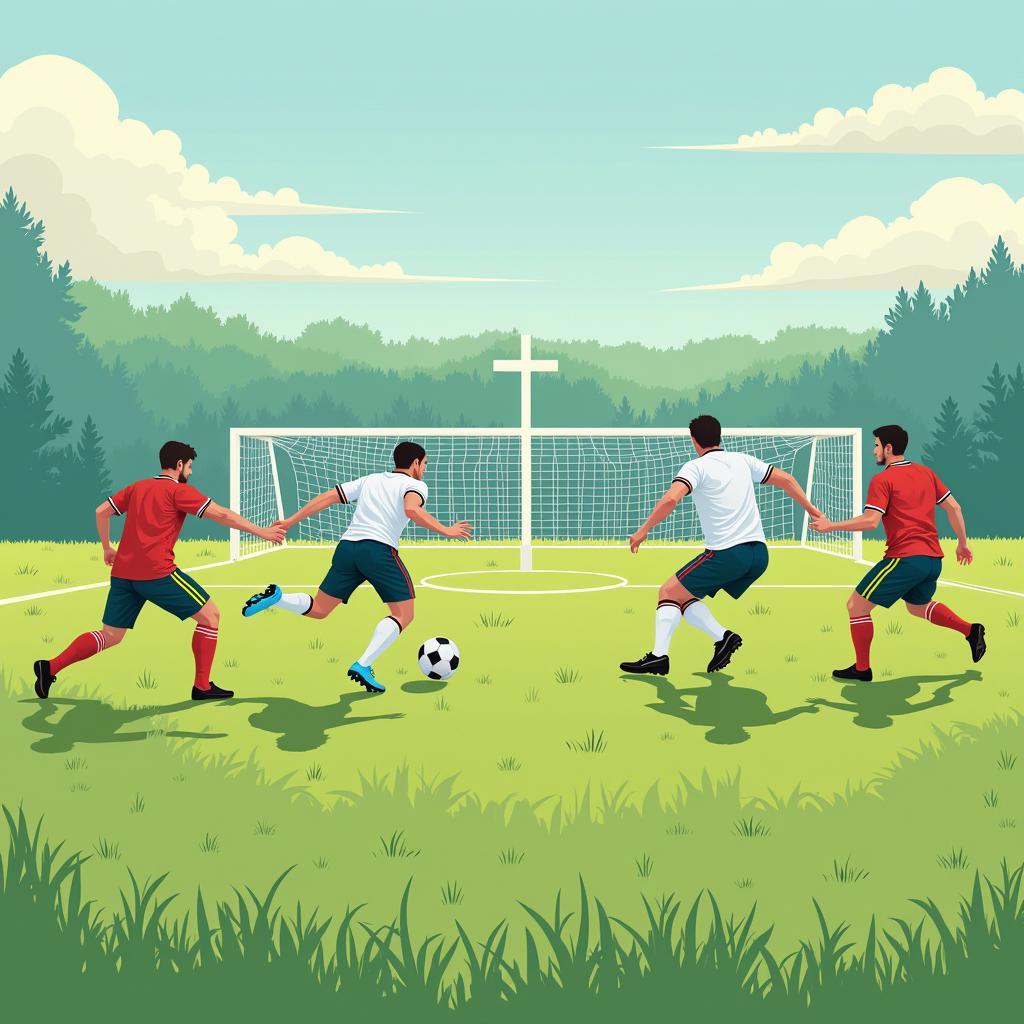Shallow Cross Football, a tactical play involving a low and driven cross into the penalty area, is a powerful tool in modern football. This article explores the intricacies of shallow crossing, delving into its tactical nuances, benefits, and execution techniques for both attacking and defending teams.
Understanding Shallow Cross Football
Unlike traditional crosses aimed high into the box, shallow crosses exploit the space between the goalkeeper and the defensive line. This area, often crowded with players, becomes a battleground for attacking runs and defensive interceptions. The effectiveness of a shallow cross lies in its unpredictability and the chaos it creates within the penalty area.
Advantages of Shallow Crosses
Shallow crosses offer several advantages over high crosses:
- Increased Goal-Scoring Opportunities: The low trajectory of the cross makes it difficult for defenders to clear effectively, increasing the likelihood of deflections, rebounds, and tap-in goals.
- Unpredictability: The trajectory and speed of shallow crosses make it harder for goalkeepers to anticipate and react, creating uncertainty and opportunities for attackers to exploit.
- Suitable for Different Player Profiles: This tactic benefits teams with pacey forwards who can make darting runs to meet the cross near the goal, as well as those with strong target men capable of holding up the ball and laying it off for onrushing teammates.
Executing the Perfect Shallow Cross
A successful shallow cross requires precision, timing, and understanding between the crosser and the attackers:
- Optimal Crossing Position: The ideal crossing zone is typically wider areas of the pitch near the byline, allowing for a flatter and more driven delivery.
- Timing and Weight of the Cross: The cross must be delivered with pace and accuracy, ensuring it bypasses the first defender while staying low to avoid clearances.
- Attacking Runs: Coordinated movements from attackers are crucial. Players making runs towards the near post, far post, and penalty spot create confusion for defenders and increase the chances of connecting with the cross.
 A striker connecting with a shallow cross
A striker connecting with a shallow cross
Defending Against Shallow Crosses
Countering shallow crosses requires disciplined defensive organization and anticipation:
- Compact Defensive Shape: A narrow defensive line reduces the space available for attackers to exploit. Defenders should maintain close proximity to each other and the goalkeeper.
- Communication and Marking Responsibilities: Clear communication is vital. Defenders must be aware of their marking assignments and track the movement of attackers, especially those making runs into the danger zones.
- Anticipating the Cross: Defenders should anticipate the cross and be prepared to clear the ball decisively. Hesitation or poor clearances can lead to dangerous opportunities for the attacking team.
Tactical Variations and Adaptations
- Overlapping Runs: Full-backs making overlapping runs can provide additional crossing options and create numerical superiority in wide areas.
- Cut-Back Crosses: Instead of aiming directly for the goal, the crosser can cut the ball back to the edge of the penalty area, creating shooting opportunities for midfielders.
- Dummy Runs: Decoy runs from attackers can drag defenders out of position, creating space for teammates to exploit the shallow cross.
 Defensive line intercepting a shallow cross
Defensive line intercepting a shallow cross
Conclusion
Shallow cross football is a potent attacking weapon that can unlock defenses and create goal-scoring opportunities. Its effectiveness depends on precise execution, coordinated movement, and tactical awareness. By mastering the techniques and understanding the nuances of shallow crossing, both attacking and defending teams can significantly impact their performance on the field.
FAQ
1. What makes a shallow cross different from a regular cross?
A shallow cross is a low and driven pass into the penalty box, aimed between the goalkeeper and the last line of defenders.
2. What are the benefits of using a shallow cross tactic?
Shallow crosses are difficult to defend against because they create chaos in the box. They are ideal for quick attacks and can lead to tap-ins, deflections, and scoring opportunities.
3. How can defenders effectively counter shallow crosses?
Defenders need to maintain a compact defensive shape, communicate clearly, track the movement of attackers, and be prepared to clear the ball decisively.
4. Are there different variations of shallow crosses?
Yes, variations include overlapping runs from full-backs, cut-back crosses to the edge of the box, and dummy runs from attackers to create space.
5. Can any team utilize the shallow cross strategy?
While particularly effective for teams with pacy forwards or strong target men, any team can benefit from incorporating shallow crosses into their attacking repertoire.
For any assistance, please contact us: Phone: 0902476650, Email: [email protected] or visit us at 139 Đ. Võ Văn Kiệt, Hoà Long, Bà Rịa, Bà Rịa – Vũng Tàu, Vietnam. We have a 24/7 customer support team ready to assist you.





